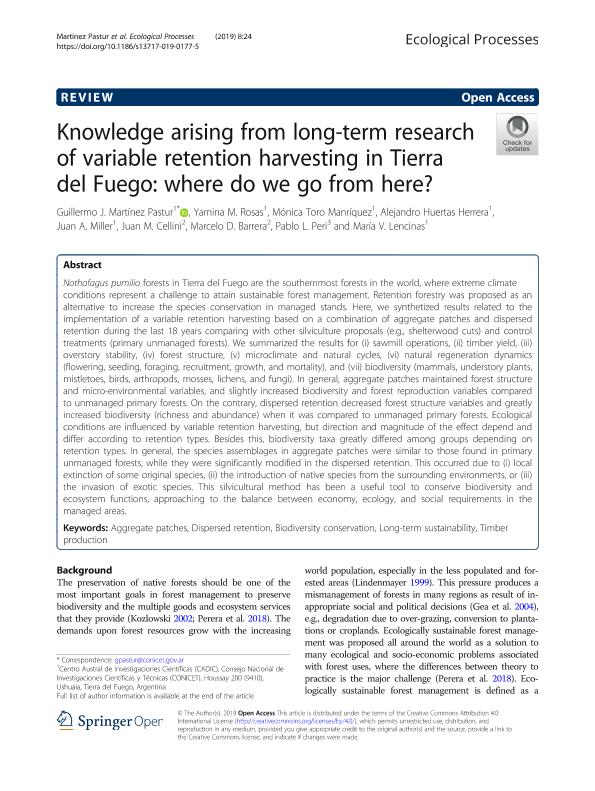Artículo
Knowledge arising from long-term research of variable retention harvesting in Tierra del Fuego: where do we go from here?
Martínez Pastur, Guillermo José ; Rosas, Yamina Micaela
; Rosas, Yamina Micaela ; Toro Manríquez, Mónica del Rosario
; Toro Manríquez, Mónica del Rosario ; Huertas Herrera, Alejandro
; Huertas Herrera, Alejandro ; Miller, Juan Andrés
; Miller, Juan Andrés ; Cellini, Juan Manuel; Barrera, Marcelo Daniel; Lencinas, María Vanessa
; Cellini, Juan Manuel; Barrera, Marcelo Daniel; Lencinas, María Vanessa
 ; Rosas, Yamina Micaela
; Rosas, Yamina Micaela ; Toro Manríquez, Mónica del Rosario
; Toro Manríquez, Mónica del Rosario ; Huertas Herrera, Alejandro
; Huertas Herrera, Alejandro ; Miller, Juan Andrés
; Miller, Juan Andrés ; Cellini, Juan Manuel; Barrera, Marcelo Daniel; Lencinas, María Vanessa
; Cellini, Juan Manuel; Barrera, Marcelo Daniel; Lencinas, María Vanessa
Fecha de publicación:
07/2019
Editorial:
Springer
Revista:
Ecological Processes
ISSN:
2192-1709
Idioma:
Inglés
Tipo de recurso:
Artículo publicado
Clasificación temática:
Resumen
Nothofagus pumilio forests in Tierra del Fuego are the southernmost forests in the world, where extreme climate conditions represent a challenge to attain sustainable forest management. Retention forestry was proposed as an alternative to increase the species conservation in managed stands. Here, we synthetized results related to the implementation of a variable retention harvesting based on a combination of aggregate patches and dispersed retention during the last 18 years comparing with other silviculture proposals (e.g., shelterwood cuts) and control treatments (primary unmanaged forests). We summarized the results for (i) sawmill operations, (ii) timber yield, (iii) overstory stability, (iv) forest structure, (v) microclimate and natural cycles, (vi) natural regeneration dynamics (flowering, seeding, foraging, recruitment, growth, and mortality), and (vii) biodiversity (mammals, understory plants, mistletoes, birds, arthropods, mosses, lichens, and fungi). In general, aggregate patches maintained forest structure and micro-environmental variables, and slightly increased biodiversity and forest reproduction variables compared to unmanaged primary forests. On the contrary, dispersed retention decreased forest structure variables and greatly increased biodiversity (richness and abundance) when it was compared to unmanaged primary forests. Ecological conditions are influenced by variable retention harvesting, but direction and magnitude of the effect depend and differ according to retention types. Besides this, biodiversity taxa greatly differed among groups depending on retention types. In general, the species assemblages in aggregate patches were similar to those found in primary unmanaged forests, while they were significantly modified in the dispersed retention. This occurred due to (i) local extinction of some original species, (ii) the introduction of native species from the surrounding environments, or (iii) the invasion of exotic species. This silvicultural method has been a useful tool to conserve biodiversity and ecosystem functions, approaching to the balance between economy, ecology, and social requirements in the managed areas.
Archivos asociados
Licencia
Identificadores
Colecciones
Articulos(CADIC)
Articulos de CENTRO AUSTRAL DE INVESTIGACIONES CIENTIFICAS
Articulos de CENTRO AUSTRAL DE INVESTIGACIONES CIENTIFICAS
Articulos(SEDE CENTRAL)
Articulos de SEDE CENTRAL
Articulos de SEDE CENTRAL
Citación
Martínez Pastur, Guillermo José; Rosas, Yamina Micaela; Toro Manríquez, Mónica del Rosario; Huertas Herrera, Alejandro; Miller, Juan Andrés; et al.; Knowledge arising from long-term research of variable retention harvesting in Tierra del Fuego: where do we go from here?; Springer; Ecological Processes; 8; 1; 7-2019; 24-24
Compartir
Altmétricas



